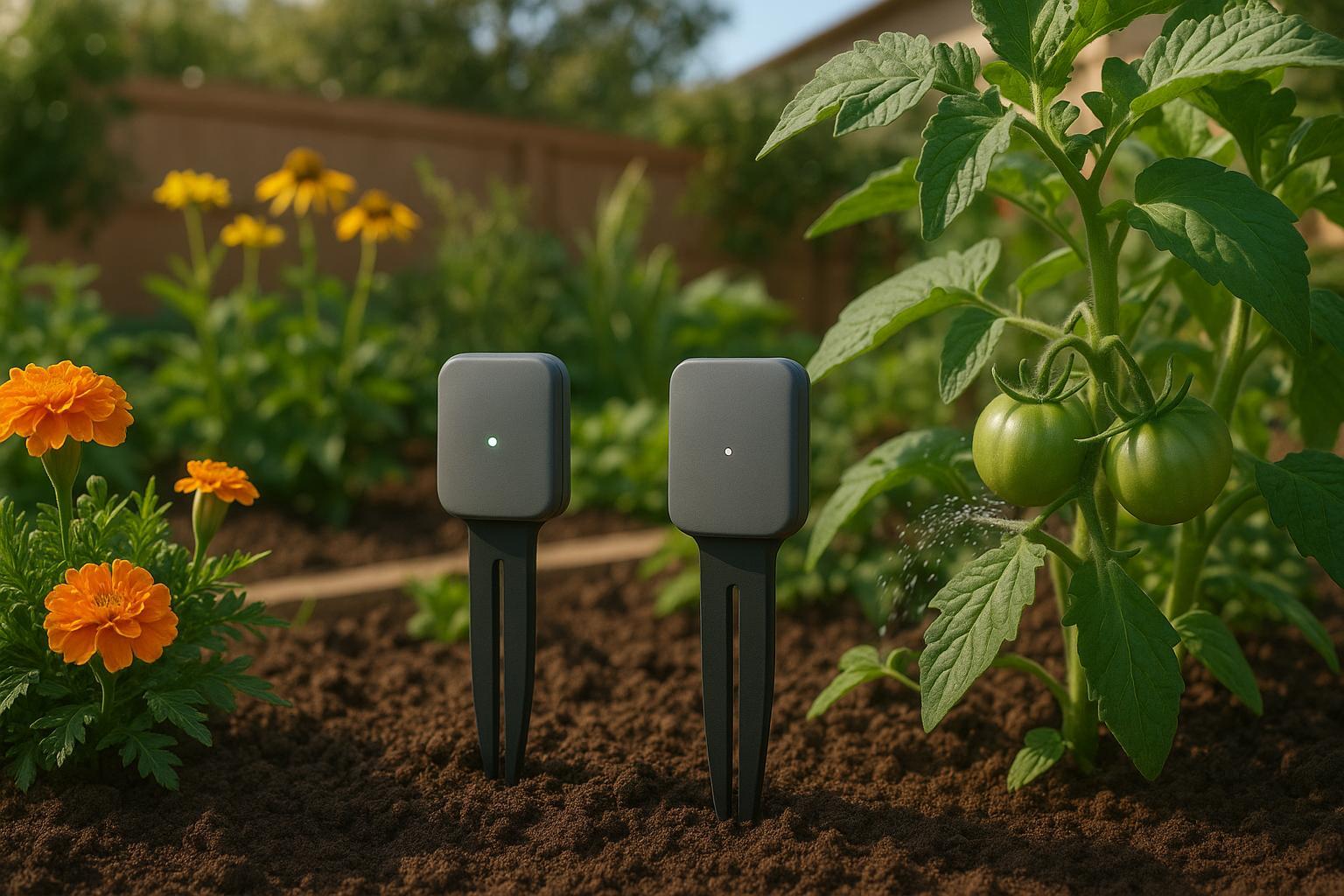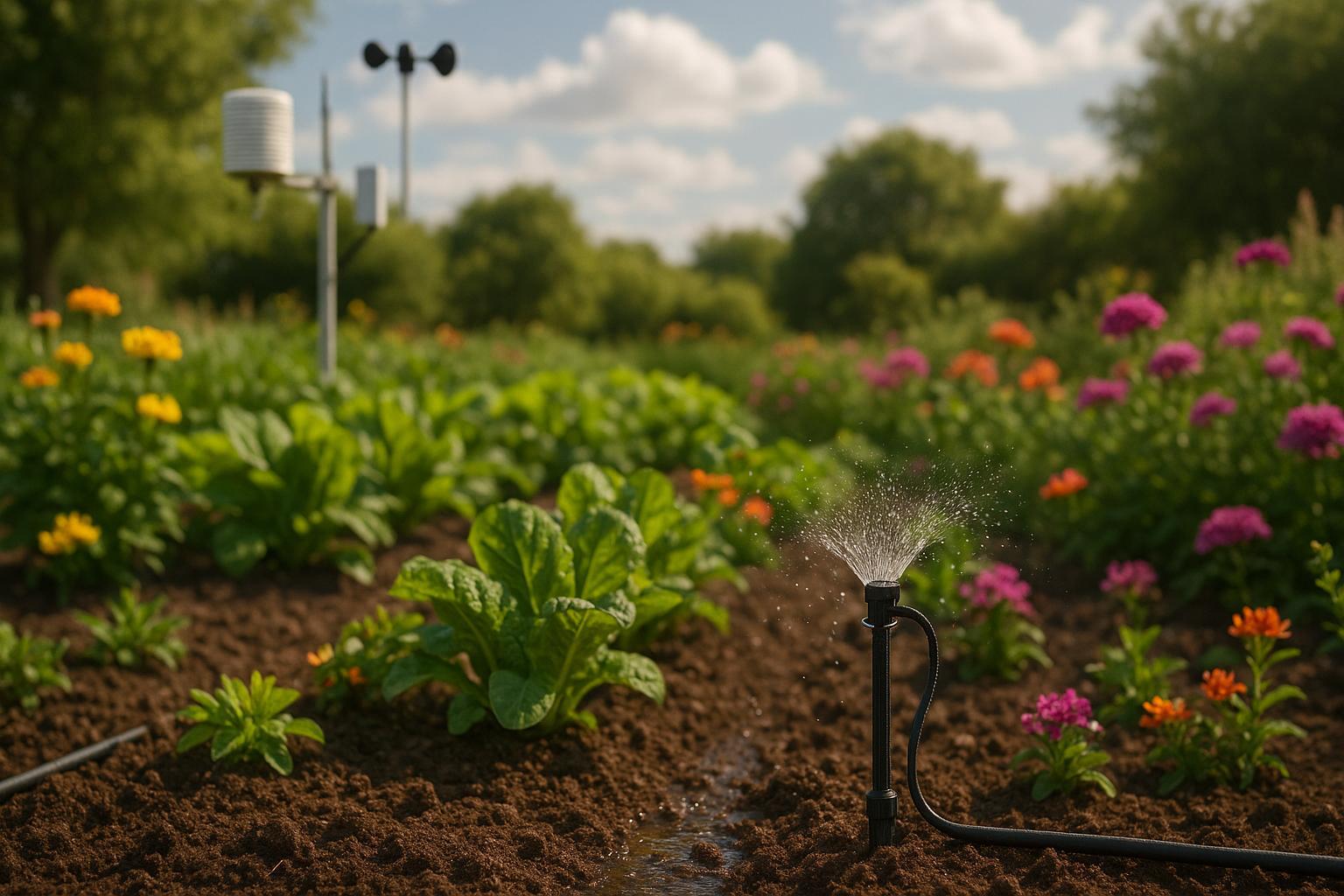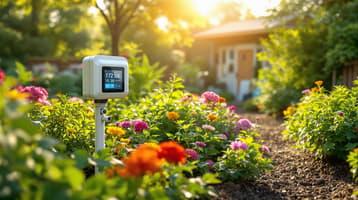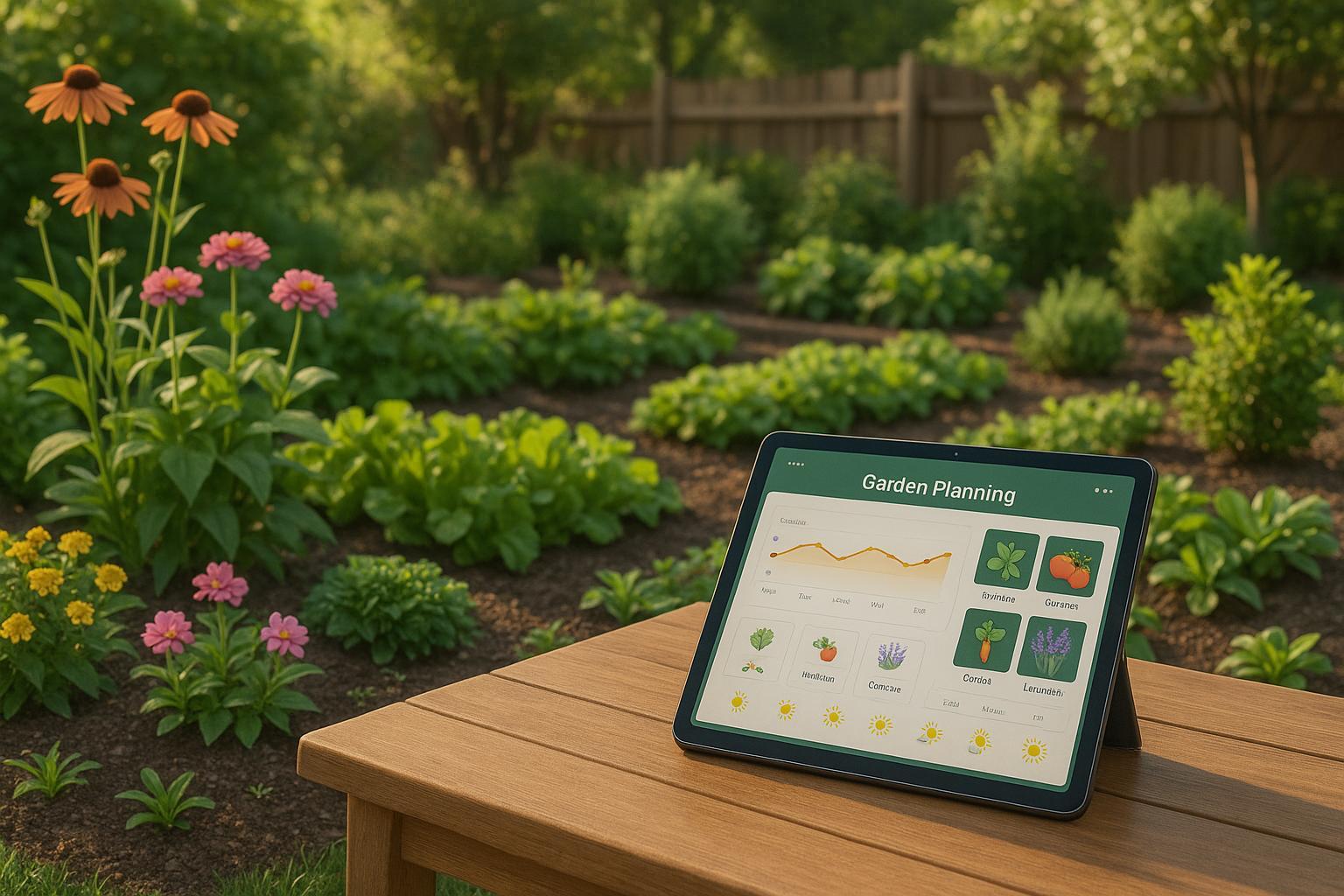AI-Powered Ventilation for Climate-Specific Gardens

AI-powered ventilation systems are transforming how gardens are managed by using machine learning and real-time sensors to create precise climate control. Unlike fixed-schedule systems, these solutions adjust airflow, temperature, and humidity based on your garden's conditions, improving plant health and reducing energy waste. Here's what makes them stand out:
- Smart Sensors: Monitor temperature, humidity, and CO₂ levels.
- Automated Hardware: Fans, vents, and filtration systems ensure optimal airflow and cleanliness.
- Weather Integration: Uses forecasts and local climate data for better decisions.
- Energy Efficiency: Operates only when needed, saving resources.
These systems work well across diverse U.S. climates, from hot deserts to humid subtropics, offering tailored solutions for each region. While they require higher upfront costs and maintenance, their ability to learn and refine over time makes them a practical choice for gardeners seeking precise and efficient climate management.
The FIRST AI Controller for Growing | AC Infinity Controller AI+

Main Components of AI-Powered Ventilation Systems
Getting familiar with the key elements of AI-powered ventilation systems can help you decide what’s best for your garden. These systems combine advanced hardware and smart software to create an efficient way to manage your garden’s climate.
Hardware Components
The hardware in AI ventilation systems works together to maintain the perfect environment for your plants. At the core are smart sensors, which monitor essential conditions like temperature, humidity, and CO₂ levels.
- Temperature sensors keep track of both air and soil temperatures.
- Humidity sensors ensure proper moisture levels.
- CO₂ sensors support photosynthesis by maintaining the right gas balance.
To act on this data, smart fans and ventilation units adjust airflow based on current needs. Variable-speed fans can shift from gentle air circulation to stronger cooling, depending on the situation. Automated vents open and close as needed, creating natural airflow patterns that mimic outdoor conditions.
Filtration systems play a crucial role in protecting your plants. HEPA filters capture tiny particles as small as 0.3 microns, while activated carbon filters remove odors and harmful chemicals often found in urban environments.
For additional climate control, actuators like misting systems, heating elements, and dehumidifiers step in. These tools work together to create a balanced environment, tailored to your garden’s specific needs, whether you’re dealing with dry, cold, or overly humid conditions.
While the hardware collects and acts on environmental data, the software is what makes the system truly intelligent.
AI Software Functions
The software in AI ventilation systems processes a massive amount of data to make smart decisions for your garden. Machine learning algorithms analyze patterns in temperature, humidity, and plant responses, constantly learning and improving to fine-tune your garden’s microclimate.
With predictive modeling, the system can anticipate your plants’ needs. For instance, as tomato plants near their flowering stage, the AI may increase ventilation to prevent humidity-related diseases.
The system’s real-time adjustment capabilities allow it to react within minutes to changes, automatically kicking on cooling, heating, or dehumidification as needed.
A user-friendly interface makes all this complexity easy to understand. Through mobile apps or web dashboards, you can monitor current conditions, review historical trends, and track the system’s performance. This gives you the tools to oversee your garden remotely and make informed decisions.
External Data Integration
AI ventilation systems don’t just rely on internal sensors - they also incorporate external data to refine their performance. Weather forecast integration helps the system prepare for upcoming changes, whether it’s a sudden drop in temperature or an increase in humidity.
- Meteorological data feeds provide details on temperature shifts, precipitation, and more, helping the system adjust ahead of time.
- Regional climate databases offer insights into long-term weather trends, guiding decisions like when to switch ventilation modes for seasonal changes.
- Air quality monitoring networks supply real-time updates on outdoor pollution and pollen levels. The system uses this data to decide when to boost filtration, close vents, or switch to recirculated air to protect your plants.
- Satellite imagery and remote sensing data give a broader view of regional weather patterns, helping the AI make smarter predictions about how to manage your garden’s climate.
AI Ventilation for U.S. Climate Zones
The United States spans a wide range of climates, each presenting its own set of challenges for garden environments. AI-powered ventilation systems offer a smart solution by adapting to local weather conditions, seasonal patterns, and environmental factors in real time. These systems ensure precise control tailored to the needs of different regions.
Hot and Dry Climates
In areas like Arizona, Nevada, and parts of California and Texas, where heat and aridity dominate, AI ventilation systems focus on cooling efficiently while conserving water. These systems track ambient temperatures and humidity to take advantage of cooler periods and minimize water usage. They also monitor air quality, automatically boosting filtration when dust levels rise, ensuring a clean and well-ventilated environment.
Humid and Subtropical Regions
Southeastern states such as Florida, Georgia, Louisiana, and the coastal Carolinas face challenges from high humidity. In these regions, AI systems prioritize dehumidification and prevent moisture-related problems. By continuously monitoring conditions, they adjust airflow to avoid stagnant air pockets, promoting healthier plant growth. The system fine-tunes its settings throughout the day and across seasons, adapting to both wet and dry periods.
Cold and Temperate Climates
In northern states and mountainous areas, retaining heat while maintaining energy efficiency is crucial. AI ventilation systems in these regions minimize unnecessary air exchange to conserve warmth and ensure even heat distribution. They also work with smart grid data to operate during off-peak hours, optimizing energy use and reducing waste[1].
sbb-itb-4d6a8dd
🚀 Ready to Reinvent Your Garden?
Join thousands of homeowners who have transformed their gardens using our AI design tool. Upload one photo to explore endless possibilities.
Get your AI garden designs →Benefits and Challenges of AI-Powered Ventilation
AI-powered ventilation systems bring a modern twist to managing garden climates, offering smarter solutions while tackling some notable hurdles. Here's a closer look at what they bring to the table.
Benefits of AI Ventilation
- Better Energy Use: These systems adjust on the fly to make the most of energy, cutting down on waste.
- Smart Climate Control: By factoring in outdoor temperatures, humidity, and seasonal shifts, they create stable environments tailored to your garden's needs.
- Less Hands-On Work: Automation reduces the need for constant monitoring, freeing up time for other gardening tasks.
- Healthier Plants: Consistent environmental conditions help reduce stress on plants, encouraging better growth and productivity.
- Learning and Adapting: With continuous data collection, these systems get smarter over time, offering increasingly precise climate management.
Even with these perks, there are challenges that come with adopting this technology.
Challenges to Consider
- Higher Upfront Costs: Compared to traditional systems, AI-powered solutions require a bigger initial investment.
- Complex Setup: Installation and operation demand professional expertise, along with regular updates and maintenance.
- Reliance on External Data: These systems depend on weather forecasts and internet connectivity, which can be a weak link if disruptions occur.
- Regular Maintenance: Advanced sensors and software need periodic calibration and updates to stay accurate.
- Learning Curve: New systems take time to adjust as they collect data and learn the specific patterns of your garden.
Comparing these systems to traditional options sheds more light on their strengths and weaknesses.
AI Ventilation vs. Traditional Systems Comparison
| Feature | AI-Powered Systems | Traditional Systems |
|---|---|---|
| Initial Investment | Higher upfront cost | Lower initial cost |
| Energy Efficiency | Adaptive and optimized | Fixed, less efficient |
| Climate Control | Dynamic, multi-factor adjustments | Static, schedule-based |
| Maintenance Needs | Software and sensor upkeep | Primarily mechanical upkeep |
| Adaptability | Learns and improves over time | Fixed capabilities |
While AI-powered systems may require a larger investment and more technical upkeep, their ability to adapt and optimize can lead to more efficient and effective climate management in the long run.
How to Install AI Ventilation in Your Garden
Setting up an AI ventilation system for your garden is a big step toward creating a climate-responsive space for your plants. The process requires careful planning and execution to ensure everything works seamlessly.
Assessing Climate and Garden Needs
Start by evaluating your garden's specific requirements. Identify your USDA Hardiness Zone and take note of local climate trends. Measure and document different sections of your garden - both open and sheltered areas - to determine how many fans or vents you’ll need.
Pay attention to your plant varieties and their individual needs for temperature and humidity. Some plants thrive in cooler, drier conditions, while others prefer warmth and moisture. Also, identify microclimates within your garden, like spots that are naturally warmer or more humid, to better customize the ventilation system for your plants.
Don’t forget to check your electrical setup. Make sure your existing infrastructure can handle the power demands of the system, and think about how seasonal changes might affect its performance. Once you’ve gathered all this information, you’ll be ready to choose the right equipment for your garden.
Selecting and Installing AI Systems
Pick hardware that matches your garden’s climate. If you live in a hot, dry area, prioritize systems with strong cooling features and reliable sensors. In humid regions, look for equipment designed to manage moisture effectively.
When choosing sensors, accuracy is key. They should monitor essential factors like temperature and humidity without being affected by direct sunlight or water exposure. Proper placement is just as important - tools like AIGardenPlanner can help you figure out the best spots for sensors and vents based on your garden’s layout.
Install the main control unit in a weatherproof enclosure located centrally in your garden. This ensures smooth communication with all sensors and actuators. Protect the wiring by running it through electrical conduits in less exposed areas, and position fans and vents to complement natural airflow. If you’re using multiple fans, space them out to maintain consistent air circulation.
Connect the system to your home’s Wi-Fi network with a dedicated connection, and set up initial parameters, leaving room for future adjustments.
Maximizing Efficiency and Troubleshooting
Once your system is up and running, it’s time to fine-tune its performance. Let the system operate for a short learning period before making any major adjustments. Monitor energy usage early on - if you notice unexpected spikes, review the sensor settings and fan operations as potential culprits.
Address connectivity issues promptly. If certain parts of your garden have weak Wi-Fi coverage, consider adding a Wi-Fi extender. It’s also smart to have a backup power source to keep the system running during outages.
Regularly calibrate the sensors, especially in the early stages, and cross-check their readings with independent instruments if necessary. Clean the sensor housings and adjust their placement if you notice inaccurate readings.
Prepare for extreme weather by setting up manual override options. This allows you to take control of the system during severe conditions. Keep an eye on plant health indicators - like changes in leaf color, growth, or flowering - as these can tell you how well the system is working. Maintaining a log of adjustments and observations can help you refine the system over time.
The Future of AI in Garden Ventilation
AI-powered ventilation systems are set to reshape how we approach climate-specific gardening. As technology progresses, these systems are becoming more advanced, easier to use, and affordable for everyday gardeners across the United States.
By combining machine learning with environmental sensors, future systems will fine-tune climate control based on real-time data. Unlike traditional setups that follow fixed schedules, AI-driven solutions will adapt dynamically. For instance, as temperatures climb, the system could cool a greenhouse, or it might adjust humidity levels during a dry spell by analyzing both sensor feedback and weather forecasts.
Connectivity is also expected to evolve dramatically. Beyond basic Wi-Fi, upcoming designs aim to integrate various climate data for precise management. Imagine a ventilation system that collaborates with irrigation controllers and shading devices, working together to maintain ideal growing conditions. This merging of data not only improves performance but also makes these systems more convenient and cost-effective.
On top of smarter connectivity, falling component costs are bringing these innovations within reach for more homeowners. What once required custom installations is now moving toward plug-and-play solutions, making advanced gardening technology accessible without needing technical expertise.
Energy efficiency is another priority. AI-powered ventilation systems of the future could minimize energy use by determining when natural airflow is sufficient versus when mechanical cooling or heating is necessary. With solar-powered options becoming more practical, even off-grid gardens could enjoy intelligent climate control.
Planning tools like AIGardenPlanner are also gaining importance as these technologies advance. Tools like this analyze your garden’s layout, plant choices, and local climate to recommend the best ventilation setup and plant varieties suited to your environment.
Regional customization will play a vital role as well. Just as earlier sections highlighted solutions tailored to different U.S. climates, future systems will take this a step further, addressing specific local challenges. For example, a garden in Phoenix, Arizona, will have vastly different optimization needs compared to one in Miami, Florida. AI systems will factor in these microclimates to boost efficiency and improve plant health across various growing zones.
Looking ahead, we may see fully integrated garden ecosystems where ventilation, irrigation, lighting, and plant monitoring work as one seamless unit. These systems will adapt in real time, responding to both immediate and seasonal changes, creating self-regulating environments that ensure optimal growing conditions with minimal effort from gardeners.
FAQs
How do AI-powered ventilation systems adapt to different U.S. climate zones for better garden care?
AI-powered ventilation systems take advantage of advanced algorithms to fine-tune airflow and temperature based on local weather patterns and real-time sensor data. By keeping an eye on critical elements like humidity, temperature, and air quality, these systems adapt to create the perfect conditions for gardens, no matter the climate zone in the U.S.
Equipped with features like real-time adjustments and IoT-connected sensors, these systems not only promote healthy plant growth but also optimize energy usage. They’re a game-changer for gardeners dealing with the unpredictable and varied weather across the country.
What are the long-term financial benefits of using an AI-powered ventilation system for your garden?
AI-powered ventilation systems can deliver impressive savings over time by fine-tuning energy usage, potentially cutting energy costs by as much as 30%. They work by constantly adjusting to changes in the environment, ensuring operations stay efficient and energy waste is kept to a minimum.
On top of that, these systems come with smart features that help reduce maintenance costs. By minimizing wear and tear, they lead to fewer breakdowns and lower repair expenses in the long run. This makes them a budget-friendly and dependable choice for maintaining optimal garden conditions suited to your local climate.
How do AI-powered ventilation systems work with other smart gardening tools to create a fully automated garden?
AI-powered ventilation systems integrate effortlessly with other smart gardening tools like IoT sensors, automated irrigation systems, and environmental monitors. Together, they form a fully automated setup designed to keep your garden running smoothly. These tools gather real-time data on key factors like soil moisture, temperature, and humidity. AI then processes this information to fine-tune ventilation, watering, and lighting, creating the perfect environment for plant growth.
When these technologies are connected through a central platform, your garden can adapt instantly to changing conditions. This not only minimizes resource waste but also promotes healthier, more vibrant plants. The result? A sustainable, low-maintenance gardening experience tailored to your local climate and specific garden requirements.
🎨 Visualize Your Dream Garden Today!
Transform any outdoor space into a professional landscape design in minutes. Just upload a photo, choose your style, and let our AI do the rest.
Start your garden transformation now →Related posts
Related Articles

Smart Soil Sensors with Home Assistant
Utilize smart soil sensors with Home Assistant to automate garden watering, enhancing plant health while conserving water efficiently.

Small Garden Design: 10 Tips to Maximize Limited Space
Transform your small garden into a functional, inviting space with tips on vertical gardening, space-saving furniture, and strategic plant choices.

AI Tools for Seasonal Irrigation Forecasting
AI irrigation systems optimize water use and plant care by analyzing weather and soil conditions, ensuring healthier gardens and cost savings.

Digital vs Traditional Garden Design: Pros and Cons
Explore the advantages and challenges of digital and manual garden design methods to find the best approach for your project.

How AI Predicts Garden Maintenance Needs
Explore how AI enhances garden maintenance by optimizing watering, fertilizing, and pruning schedules for healthier plants and efficient resource use.

AI Climate Data for Garden Planning
Explore how AI tools transform garden planning with tailored plant recommendations, weather insights, and sustainable designs for thriving ecosystems.